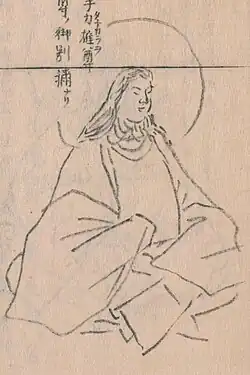Takuhadachiji-hime
| Takuhadachiji-hime | |
|---|---|
 | |
| Genealogy | |
| Parents |
|
| Siblings | Futodama, Omoikane |
| Consort | Amenooshihomimi |
| Children | Ninigi-no-Mikoto, Amenohoakari |
Takuhadachiji-hime (栲幡千千姫命), is a deity that appears in the creation story of the "Kojiki" and "Nihon Shoki." She is the daughter of the god Takamimusubi[1][2][3] and younger sister of Omoikane.[3] She is the goddess of textiles and mother of Ninigi-no-Mikoto and Amenohoakari,[4][5][6] and thus an ancestor of Jimmu.[5]
The meaning of her name is not entirely clear, but "Takuhadachiji-hime" is believed to mean "many woven fabrics" or "many beautiful fabrics." There are also theories that the name refers to the deity as a skilled weaver or that it relates to the island of Toyoakitsu.[1]
In the creation story, Takuhadachiji-hime is said to be a part of the pantheon of gods who descended from the heavens to create the world. The different texts give different genealogies and roles to the deity, but she is consistently represented as a divine being associated with creation and fertility.[1]
Genealogy
- Red background is female.
- Green background means groups
- Bold letters are three generations of Hyuga.
References
- ^ a b c "万幡豊秋津師比売命 – 國學院大學 古典文化学事業". kojiki.kokugakuin.ac.jp. Retrieved 2023-01-17.
- ^ "Encyclopedia of Shinto - Home : Kami in Classic Texts : Futodama". eos.kokugakuin.ac.jp. Retrieved 2020-11-07.
- ^ a b https://archive.today/20230406174104/https://d-museum.kokugakuin.ac.jp/eos/detail/?id=9716
- ^ "タクハタチヂヒメ". nihonsinwa.com (in Japanese). Retrieved 2023-01-17.
- ^ a b "栲幡千千姫命(たくはたちぢひめのみこと)ご利益と神社". xn--u9ju32nb2az79btea.asia (in Japanese). Retrieved 2023-01-17.
- ^ "Ninigi". Mythopedia. Retrieved 2023-04-06.
- ^ a b c Borgen, Robert; Ury, Marian (April 1990). "Readable Japanese Mythology: Selections from Nihon shoki and Kojiki" (PDF). The Journal of the Association of Teachers of Japanese. 24 (1). American Association of Teachers of Japanese: 61–97. doi:10.2307/489230. JSTOR 489230. Retrieved 12 April 2020.
- ^ a b https://archive.today/20230406174104/https://d-museum.kokugakuin.ac.jp/eos/detail/?id=9716
- ^ a b c d e Nihongi: Chronicles of Japan from the Earliest Times to A.D. 697, translated from the original Chinese and Japanese by William George Aston. Book II, page 73. Tuttle Publishing. Tra edition (July 2005). First edition published 1972. ISBN 978-0-8048-3674-6
- ^ a b c Akima, Toshio (1993). "The Origins of the Grand Shrine of Ise and the Cult of the Sun Goddess Amaterasu Ōmikami". Japan Review. 4 (4): 143. ISSN 0915-0986. JSTOR 25790929.
- ^ a b c Tsugita, Masaki (2001) [1977]. 古事記 (上) 全訳注 [Complete Translated and Annotated Kojiki, Part 1]. Vol. 38. 講談社学術文庫. p. 205. ISBN 4-06-158207-0.
- ^ a b c d e The History of Nations: Japan. Dept. of education. Japan. H. W. Snow. 1910.
- ^ The Kojiki: Records of Ancient Matters. Tuttle Publishing. 19 June 2012. p. 218. ISBN 978-1-4629-0511-9.